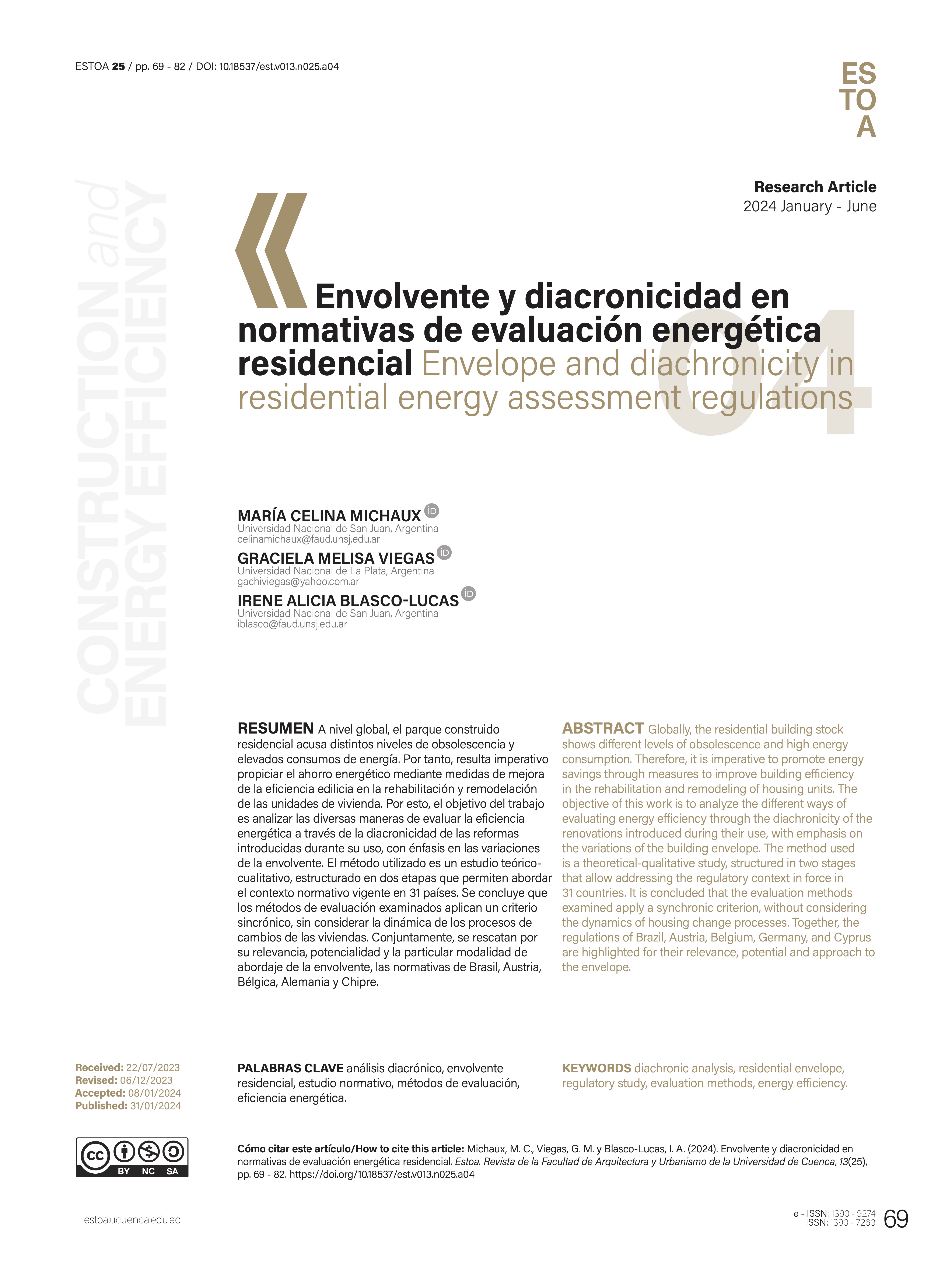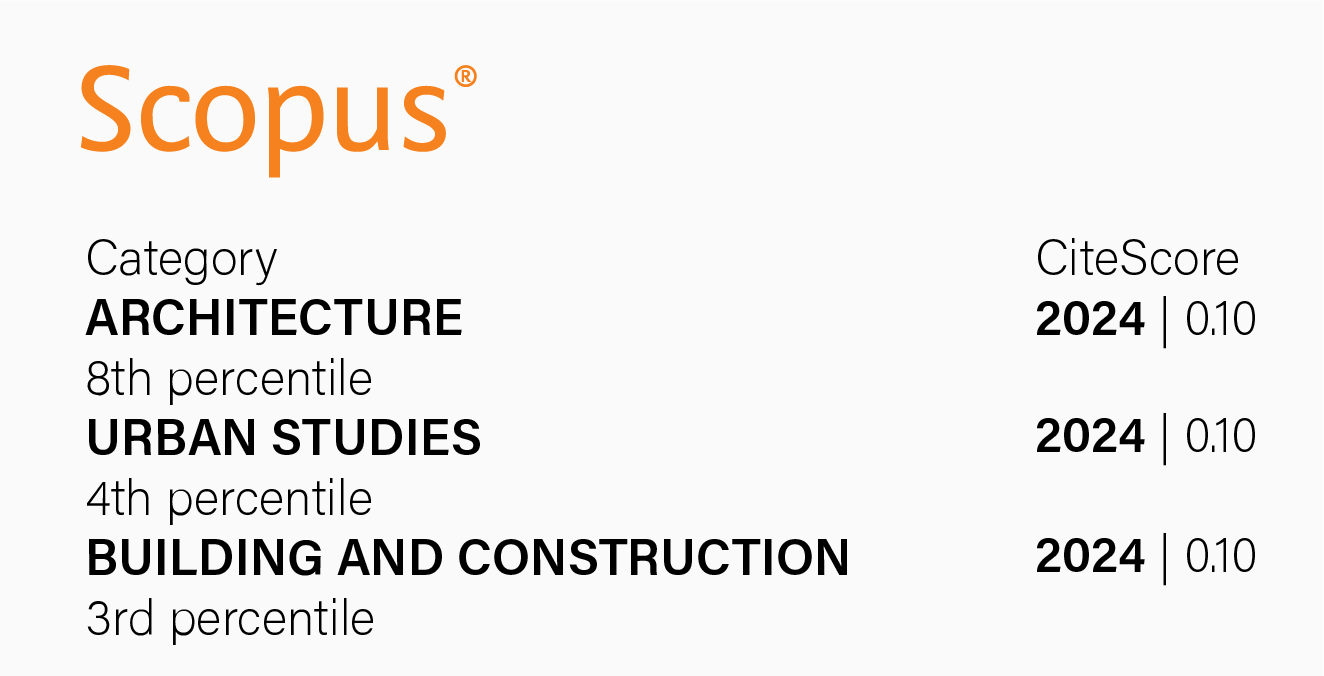Envelope and diachronicity in residential energy assessment regulations
DOI:
https://doi.org/10.18537/est.v013.n025.a04Keywords:
diachronic analysis, residential envelope, regulatory study, evaluation methods, energy efficiencyAbstract
Globally, the residential building stock shows different levels of obsolescence and high energy consumption. Therefore, it is imperative to promote energy savings through measures to improve building efficiency in the rehabilitation and remodeling of housing units. The objective of this work is to analyze the different ways of evaluating energy efficiency through the diachronicity of the renovations introduced during their use, with emphasis on the variations of the building envelope. The method used is a theoretical-qualitative study, structured in two stages that allow addressing the regulatory context in force in 31 countries. It is concluded that the evaluation methods examined apply a synchronic criterion, without considering the dynamics of housing change processes. Together, the regulations of Brazil, Austria, Belgium, Germany, and Cyprus are highlighted for their relevance, potential and approach to the envelope.
Downloads
References
Abu Dhabi Urban Planning Council. (2010). The Pearl Rating System for Estidama. Building Rating System Design and Construction. Version 1. https://www.solarthermalworld.org/sites/default/files/news/file/2015-05-04/estidama_construction_rating_certificate.pdf
Altmann-Mavaddat, N., Taufratzhofer, G., Trnka, G., Jilek, W., y Simader, G. (diciembre de 2016). Implementation of the EPBD in Austria. Energy Performance of Buildings. https://epbd-ca.eu/ca-outcomes/outcomes-2015-2018/book-2018/countries/austria
Belenguer, E., García, N., y Sabater, G. (2019). Assessment of energy efficiency improvement methods in the residential sector through the development of economic experiments. SN Applied Sciences, 1(1409). https://doi.org/10.1007/s42452-019-1439-7
BMVBS. (2010). Monitoring and evaluation of energy certification in practice with focus on central European states. Federal Ministry of Transport, Building and Urban Development.
Bruxelles Environnement. (2023a). Certification de la performance énergétique des habitations individuelles. Protocole Livre I – Generalites [Manual de certificación del rendimiento energético de viviendas individuales. Libro de protocolo I - Generalidades]. Sous-Division Energie, Air, Climat et Bâtiments durables — Département Certification PEB.
Bruxelles Environnement. (2023b). Certification de la performance énergétique des habitations individuelles. Protocole Livre II - Enveloppe [Manual de certificación del rendimiento energético de viviendas individuales. Libro de protocolo II - Envolvente]. Sous-Division Energie, Air, Climat et Bâtiments durables— Département Certification PEB.
Castro Alvarez, F., Vaidyanathan, S., Bastian, H., y King, J. (2018). The 2018 International Energy Efficiency Scorecard. American Council for an Energy-Efficient Economy. https://www.aceee.org/sites/default/files/publications/researchreports/i1801.pdf
Centre for Energy Savings in Buildings. (2018). Energy Requirements of BR18. A quick guide for the construction industry on the Danish Building Regulations 2018. Danish Knowledge Centre for Energy Savings in Building. https://byggeriogenergi.dk/media/2202/danishbuildingregulations_2018_energy-requirements.pdf
Chee, J. (2017). Investigations on Energy Efficient Buildings-the aim to reach zero energy buildings [Tesis de maestría. Halmstad University]. https://hh.diva-portal.org/smash/get/diva2:1078427/FULLTEXT01.pdf
Denza, A., y Lauria, M. (08 de abril de 2020). Validità dell’ Attestato di Prestazione Energetica. Validità Dell’APE. Certificato Energético. https://www.certificato-energetico.it/validita.html
Divakaran, P., Kapnopoulou, V., McMurtry, E., Seo, M., y Yu, L. (2013). Towards an integrated framework for coastal eco-cities. British Library Cataloguing. https://eprints.soton.ac.uk/359322/
Lapillonne, B. y Sudries, L. (2023). Empowering Sustainable Development through Energy Efficiency. Developing a thorough regional monitoring in Latin America. Enerdata. https://www.enerdata.net/publications/executive-briefing/latin-america-energy-efficiency.html
Galiano Garrigós, A. (2013). Análisis comparado de las metodologías de evaluación y certificación del comportamiento energético de los edificios en la Unión Europea [Tesis doctoral, Universidad de Alicante]. file:///C:/Users/Usuario/Downloads/tesis_antoniogaliano.pdf
Georgiou, G., Eftekhari, M., y Lupton, T. (25-27 de agosto de 2015). Investigating the Effect of Tightening Residential Envelopes in the Mediterranean Region. 14th International Conference on Sustainable Energy Technologies, Nottingham, Inglaterra.
Hadjinicolaou, N. (2020). Implementation of the EPBD in Cyprus. Status in 2020. Concerted Action EPBD. https://epbd-ca.eu/wp-content/uploads/2022/03/Implementation-of-the-EPBD-in-Cyprus.pdf
Hadjinicolaou, N. (2018). EPBD implementation in Cyprus. Status in December2016. Concerted Action EPBD. https://epbd-ca.eu/wp-content/uploads/2018/08/CA-EPBD-IV-Cyprus-2018.pdf
IRAM. (2002). Norma IRAM 11605. Acondicionamiento térmico de edificios. Condiciones de habitabilidad en edificios. Valores máximos de transmitancia térmica en cerramientos opacos. Instituto argentino de normalización y certificación.
IRAM. (2017). Norma IRAM 11900. Prestaciones energéticas en viviendas. Instituto argentino de normalización y certificación.
Landgren, M. (2018). Developing a method for integrated sustainable design [Tesis doctoral, Technical University of Denmark]. https://backend.orbit.dtu.dk/ws/portalfiles/portal/178278519/Orbit_398.pdf
Michaux, M. C., Viegas, G. M., y Blasco Lucas, I. A. (2021). Evolución y crecimiento oficial en viviendas del Instituto Provincial de la Vivienda. Revista de Arquitectura, 26(41), 6–15. https://doi.org/10.5354/0719-5427.2021.65019
Milovanović, B., y Bagarić, M. (2020). How to achieve Nearly zero-energy buildings standard. Gradjevinar, 72(8), 703–720. https://doi.org/10.14256/JCE.2923.2020
Ministério do desenvolvimento, indústria e comércio exterior. (2013). Requisitos de avaliação da conformidade para eficiência energética de edificações. Instituto Nacional de Metrologia, Qualidade e Tecnologia-Inmetro. www.inmetro.gov.br
Ojanen, T., Nykänen, E., y Hemmilä, K. (2017). Rakenteellinen energiatehokkuus korjausrakentamisessa [Guía de la eficiencia energética estructural en construcciones renovadas]. Teknologian tutkimuskeskus VTT.
ROCKWOOLAB. (s.f.). Energiforbrug og energikrav. Hvordan kan varmetap og energiforbruk reduseres til et minimum? [Consumo de energía y necesidades energéticas. ¿Cómo minimizar la pérdida de calor y el consumo de energía?] Rockwool. https://info.rockwool.no/no/takisolasjonsguiden/energiforskrifter/energiforbruk-og-energikrav/
Sánchez González, J. C. (17 de abril de 2016). Pirámide de Kioto I. Arquitectura y Energía. Acento. https://acento.com.do/opinion/piramide-de-kioto-i-8340921.html
Secretaría de Ambiente y Desarrollo Sostenible. (2019). Manual de Vivienda Sustentable. Ministerio de interior, obras públicas y vivienda. Secretaría de vivienda. https://www.argentina.gob.ar/ambiente/desarrollo-sostenible/vivienda/manual
Steinmeier, F. W., Merkel, A., Ltmaier, P., y Seehofer, H. (2020). Gesetz zur Vereinheitlichung des Energieeinsparrechts für Gebäude und zur Änderung weiterer Gesetze [Ley para estandarizar el ahorro de energía para edificios y para modificar otras leyes]. Deutscher Bundestag. https://dip.bundestag.de/vorgang/gesetz-zur-vereinheitlichung-des-energieeinsparrechts-f%C3%BCr-geb%C3%A4ude-und-zur-%C3%A4nderung/255322
Subramanian, S., Bastian, H., Hoffmeister, A., Jennings, B., Tolentino, C., Vaidyanathan, S., y Nadel, S. (2022). 2022 International Energy Efficiency Scorecard. ACEEE. www.aceee.org/research-report/i2201
Thermtest (10 de febrero de 2022). Building Envelopes. What they are and how they improve the energy efficiency of a structure. Thermtest Instruments. https://thermtest.com/building-envelopes-what-they-are-and-how-they-improve-the-energy-efficiency-of-a-structure
Tomadoni, M. M., y Díaz Varela, M. J. (2017). Sustentabilidad en la vivienda de interés social en mar del plata: una metodología para su evaluación a partir de indicadores. I+A Investigación + Acción, 20(19), 99–122.
Tushar, W., Lan, L., Withanage, C., En, H., Sng, K., Yuen, C., Wood, K. L., y Kumar, T. (2020). Exploiting design thinking to improve energy efficiency of buildings. Energy, 197, 117–141. https://doi.org/10.1016/j.energy.2020.117141
UNEP. (2022). 2022 Global Status Report for Buildings and Construction: Towards a Zeroemission, Efficient and Resilient Buildings and Construction Sector. Programa de las Naciones Unidas para el Medio Ambiente (PNUMA). https://www.unep.org/resources/publication/2022-global-status-report-buildings-and-construction
Visse, F., y Yeretzian, A. (2013). Energy Efficient Building Guideline for MENA Region. MED-ENEC. https://www.climamed.eu/wp-content/uploads/files/Energy-Efficient-Building_Guideline-for-MENA-Region-NOV2014.pdf
World Energy Council. (2016). World energy perspectives. World Energy Council. https://www.worldenergy.org/assets/downloads/Exec-Summary_EnergyEfficiency-A-straight-path-towards-energy-sustainability.pdf
Wu, Y., Liu, C., Hung, M., Liu, T., y Masui, T. (2019). Sectoral energy efficiency improvements in Taiwan: Evaluations using a hybrid of top-down and bottom-up models. Energy Policy, 132, 1241–1255. https://doi.org/10.1016/j.enpol.2019.06.043
Xichilos, C., y Hadjinicolaou, N. (2011). Implementation of the EPBD in Cyprus. Status in November 2010. Concerted Action EPBD. https://docplayer.net/20893588-Implementation-of-the-epbd-in-cyprus-status-in-november-2010-1-introduction-2-certification-cyprus.html

Published
How to Cite
Issue
Section
License
Copyright (c) 2024 Estoa. Journal of the Faculty of Architecture and Urbanism

This work is licensed under a Creative Commons Attribution-NonCommercial-ShareAlike 4.0 International License.
The Journal declines any responsibility for possible conflicts derived from the authorship of the works that are published in it.
The University of Cuenca in Ecuador conserves the patrimonial rights (copyright) of the published works and will favor the reuse of the same ones, these can be: copy, use, diffuse, transmit and expose publicly.
Unless otherwise indicated, all contents of the electronic edition are distributed under a Creative Commons Attribution-NonCommercial-ShareAlike 4.0 International License.



